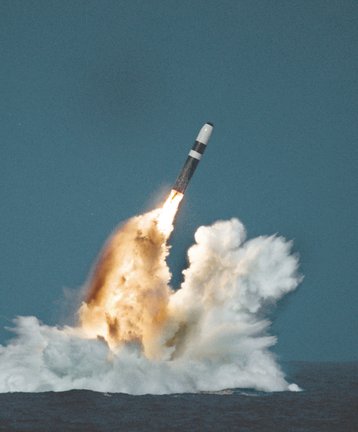The Atomic Weapons Establishment, which builds and maintain’s the UK’s nuclear weapons arsenal, has turned to high performance computing integrator OCF for a new system, which simulates nuclear weapons instead of performing actual detonation tests.
The HPC system is built on IBM’s Power8 architecture and has a separate parallel file system, Cedar 3, built on IBM Spectrum Scale. The data it uses comes from actual explosions carried out before the treaty which bans live nuclear tests.
Weapons of math destruction
The new platform runs on a suite of IBM Power systems servers with Power8 processors running the IBM AIX V7.1 and Red Hat Enterprise Linux operating systems.
It consists of of IBM Power E880, IBM Power S824L, IBM Power S812L and IBM Power S822 servers, and has an IBM tape library device to back up computation data.
“Our work to maintain and support the Trident missile system is undertaken without actual nuclear testing, which has been the case ever since the UK became a signatory to the Comprehensive Nuclear Test Ban Treaty (CTBT); this creates extraordinary scientific and technical challenges – something we’re tackling head on with OCF,” Paul Tomlinson, HPC Operations at AWE, said.
“We rely on cutting-edge science and computational methodologies to verify the safety and effectiveness of the warhead stockpile without conducting live testing. The new HPC system will be vital in this ongoing research.”
Julian Fielden, MD at OCF, added: “The work of AWE is of national importance and so its team of scientists need complete faith and trust in the HPC and big data systems in use behind the scenes, and the people deploying the technology
“Through our partnership with IBM, and the people, skills and expertise of our own team, we have been able to deliver a system which will enable AWE maintain its vital research.”
Press the virtual button
While the UK government owns the sites and facilities of the Atomic Weapons Establishment, the Ministry of Defence has a government-owned contractor-operated contract with AWE Management Limited.
AWE ML consists of three shareholders – American defense giant Lockheed Martin, British outsourcing company Serco and US technical professional services firm Jacobs Engineering Group.
The sites are run by 4,500 staff and over 2,000 contractors, who provide and maintain nuclear warheads for the UK’s Continuous At Sea Deterrent, Trident.
The Trident nuclear program consists of four Vanguard-class submarines armed with up to 8 Trident II D-5 ballistic missiles with up to 40 warheads, operated by the Royal Navy and based at Clyde Naval Base on the west coast of Scotland (at least one submarine is meant to always be on patrol).
Last summer Trident was renewed in a Parliamentary vote of 472 vote to 117, despite criticism from opposition party leader Jeremy Corbyn, extending the program’s life until at least the 2060s. In January 2017, it was revealed that the government had delayed reporting on a Trident test in which a missile veered off “in the wrong direction towards America.”
This was of course a ”launch test” with no live warhead, as the UK has agreed not to take part in actual nuclear weapons tests.along with most of the world’s nations. The warheads are tested virtually, and it is here supercomputers play their part.
Jeffrey G. Lewis, a nuclear weapons expert and the director of the East Asia Nonproliferation Program at the Monterey Institute of International Studies, told The Washington Post that computer modeling meant that “for the first time, nuclear weapons designers understand why and how thermonuclear weapons work.”
In the US, scientists use data from the 1,054 nuclear tests the country made between 1945 and 1992, in simulations conducted in Department of Energy supercomputers including Livermore in California and Los Alamos National Laboratory and Sandia National Laboratory in New Mexico.
Alan Carr, historian at Los Alamos National Laboratory, told The Next Platform: “The evolution of computers is directly tied to the evolution of nuclear weapons.”
China reportedly did similar simulations with its Tianhe-1A and Tianhe-2 supercomputers, prompting the US to block the sale of Intel Xeon processors and Xeon Phi coprocessors for an upgrade to the Tianhe-2, along with other trade embargoes.
That move may have backfired, however, with China funneling money into the development of its own chips, which were used to build the world’s most powerful computer, the Sunway TaihuLight.
On a lighter note
For those wishing to do their own nuclear bomb simulations without the aid of a supercomputer, DCD recommends Nukemap.
For those wishing to know more about how a nuclear explosion’s electromagnetic pulse can affect a data center, the history of electronic warfare, and the story of an EMP-proof data center, DCD recommends our previous article on the matter.


